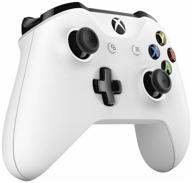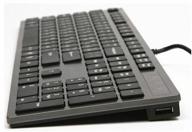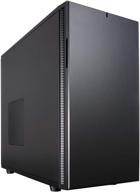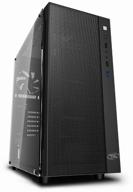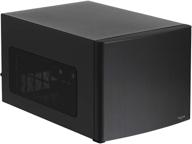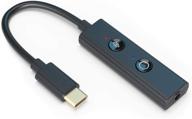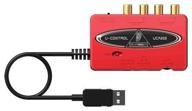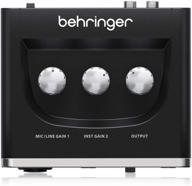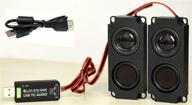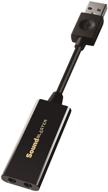Similar products
Improve Your Audio Quality with an External Sound Card
The sound card built into your computer may be good enough for basic audio playback, but for professional-grade audio production, gaming, or critical listening, you'll want to upgrade to an external sound card. External sound cards connect to your PC via USB or Firewire and bypass the lower-quality integrated audio hardware, providing significantly better audio quality and performance.
Another interesting products
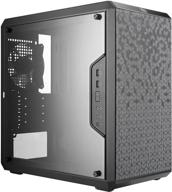

40 Review

Reduce Noise and Distortion
The DAC (digital-to-analog converter) and amplifier built into many integrated sound cards generate audible background hiss, humming, and distortion. External sound cards have higher-end DACs and amps that greatly minimize noise and distortion, resulting in clearer, cleaner playback. This is especially noticeable for studio monitoring and hi-fi listening.
Improve Frequency Response
Most integrated sound cards don't reproduce the entire audible frequency range accurately, lacking either at the low or high end. External sound cards offer flatter, fuller frequency response across the spectrum for accurate sound reproduction. This improves the listening experience for music, movies, and games.
Increase Volume Levels Without Clipping
The maximum output level on many built-in sound cards is too low, forcing you to crank up the gain to dangerously high levels. External sound cards can deliver much higher volume levels without clipping or distorting the sound. This gives you plenty of clean headroom for louder listening.
Top products in 🔊 External Sound Cards
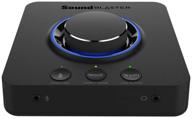

13 Review

Handle High-Resolution Audio
Integrated sound cards usually don't support high-resolution audio formats like 24-bit/192kHz. External sound cards provide connectivity for all the latest HD formats via digital connections like S/PDIF, delivering stunning audio fidelity. This transforms your PC into a high-end audio playback system.
Reduce Latency for Recording
Built-in sound cards often have very high latency, which can make recording audio problematic. External sound cards have specialized ASIO drivers and direct onboard monitoring to reduce latency to imperceptible levels. This enables real-time audio capture and playback when recording.
More I/O Options
- TRS, XLR, and optical inputs for connecting recording mics, instruments, and digital sources
- RCA line outputs to hook up powered monitors or an external amp
- MIDI input and output for controlling synths and keyboards
External sound cards provide expandability through a variety of specialized input and output options not usually found on built-in sound. This enables you to integrate the card into pro and home studios.
Dedicated Headphone Amp
Most built-in sound cards lack a dedicated headphone amp, resulting in weak headphone volume and noise. External sound cards have specialized headphone amplifiers that deliver clean power for driving high-impedance headphones. This provides loud, optimized headphone monitoring.
So if you're looking to take your computer audio to the next level for gaming, music production, or critical listening, upgrade to an external sound card. With reduced noise, expanded connectivity, and crisp detailed sound, an external DAC and headphone amp is an excellent way to drastically improve your desktop audio.
Upgrade Your PC's Sound with an External Sound Card
The built-in sound card in your PC or laptop is likely basic at best. While it may get the job done for system alerts and video calls, it's not capable of delivering a powerful, immersive audio experience for music, movies, and games.
Luckily, you can bypass your computer's integrated sound hardware and upgrade to studio-grade audio with an external sound card. External sound cards connect via USB or Firewire and provide major improvements in audio quality, 3D positional audio, and overall performance. Here's how an external sound card can upgrade your PC's sound.
Cleaner Audio Playback
External sound cards utilize high-end components like audiophile-grade DACs (digital-to-analog converters) and headphone amplifiers that minimize distortion and noise. This results in crystal clear audio playback without hum or hiss ruining your listening experience.
Surround Sound Expansion
Onboard sound chips provide basic stereo output. External sound cards support 5.1 and 7.1 surround sound for immersive positional audio. This transforms your PC into a home theater system and makes games, movies, and music come alive.
ASIO and Direct Monitoring
Software like ASIO (Audio Stream Input/Output) and direct onboard monitoring minimize latency for professional audio recording. This enables real-time monitoring and playback capture with no lag when recording vocals or instruments.
High-Resolution Audio Support
External sound cards allow your computer to handle high-resolution audio up to 24-bit/192kHz via inputs like S/PDIF optical. This provides pristine fidelity and takes advantage of high-def audio recordings.
Dedicated Headphone Amplification
Onboard sound chips often have weak headphone outputs, while external sound cards have dedicated headphone amps that deliver clean power for crisp loud headphone monitoring.
More Connectivity Options
- 1/4" and XLR inputs for mics, instruments, etc.
- MIDI I/O for connecting synths and controllers
- S/PDIF and TOSLINK optical for digital audio
External sound cards provide extra input and output options for connecting audio gear that usually can't interface directly with a computer.
Remote Mixing Controls
Some external sound cards come with remote mixers to control levels, mute, solo, etc. from your desktop without reaching around to the back of your PC.
Don't settle for lackluster built-in audio when you can equip your computer with an external sound card. With upgraded components, surround sound, and extra connectivity, external sound cards are a great way to get professional studio-quality sound from your PC.
Reduce Latency for Recording with an External Sound Card
Trying to record audio on a computer can be extremely frustrating due to latency issues. Latency is the delayed playback and monitoring of audio signals that makes it impossible to record vocals or instruments in real-time.
The built-in sound cards in most computers have very high inherent latency that cannot be fully eliminated. But you can drastically reduce recording latency down to imperceptible levels by using an external USB or Firewire audio interface.
How External Audio Interfaces Reduce Latency
External audio interfaces feature high-speed drivers like ASIO (Audio Stream Input/Output) that bypass the latency-inducing sound processing in your computer. This routes audio directly to and from the interface for lightning fast translation.
Direct hardware monitoring is another key feature of external audio interfaces. This allows the input signal to be routed directly to the headphone output before going to the computer. The dry input monitors in real-time with no lag.
Optimized Drivers
Manufacturers design drivers specifically optimized for their interfaces to achieve minimal latency. Generic built-in sound card drivers can't offer the same optimized performance.
High-Quality AD/DA Converters
External audio interfaces use pristine analog-to-digital and digital-to-analog converters that translate signals accurately with no delay. Built-in sound cards often have poor AD/DA conversion that introduces latency.
Dedicated MIDI Ports
MIDI data requires fast low-latency transmission to avoid timing issues. Dedicated MIDI input and output ports on external interfaces keep MIDI and audio transmission separate for optimal speed.
Direct Monitoring Options
Zero-latency direct monitoring mixes the raw input signal directly with the computer playback so you hear everything in real-time without delay. This enables lag-free monitoring while recording.
Onboard DSP
Onboard DSP chips provide real-time input signal processing like reverb without needing to route through software. This avoids latency introduced by software monitoring and effects.
Powerful Headphone Amplifiers
External audio interfaces feature dedicated headphone amps that can drive high levels to headphones for accurate zero-latency monitoring at loud volumes. Quieter built-in sound card outputs make latency more apparent.
Tactile Control
Monitor mixers and tactile controls on external interfaces allow for quick adjustments. Changing settings in software introduces small amounts of delay.
Dedicated Power Supply
Some external interfaces have dedicated power supplies that provide clean stable power, avoiding audio artifacts that can impact latency performance.
Using an external USB or Firewire audio interface is the easiest way to eliminate latency problems and achieve perfect real-time monitoring and recording on a computer. With their optimized drivers, converters, and routing, external interfaces will transform your recording workflow.
Add Additional Audio Inputs and Outputs with an External Sound Card
The built-in sound card in your computer likely only has a basic stereo output and microphone input. While fine for simple audio needs, this severely limits connectivity for professional studio gear and home theater setups.
Adding an external sound card is an easy way to drastically expand your computer's audio inputs and outputs for connecting instruments, mics, speakers, headphones, and other audio devices.
Common Input Options
- XLR - For connecting professional condenser microphones
- 1/4" TRS - For instruments like guitars, keyboards, and DJ gear
- RCA - For integrating professional mixers and turntables
- S/PDIF and TOSLINK - For digital sources and sound systems
- MIDI - For synths, drum machines, sequencers
Common Output Options
- TRS and XLR - For studio monitors or external headphone amps
- RCA - For connecting powered speakers or hi-fi systems
- S/PDIF and TOSLINK - For digital surround sound speakers
- MIDI - For synths, samplers, and MIDI rigs
Flexible Routing
External sound cards allow you to freely route signals and blend inputs and outputs. For example, blend multiple mics for podcasting or route guitars into synth rigs for processing.
Expandability
Many external sound cards can be expanded with additional input channels via ADAT Lightpipe. Some models are also compatible with audio interfaces for combining multiple units.
Portability
Since external sound cards are disconnected from the PC, they can be easily moved between desktop and laptop systems as needed.
Whether you need to record a full band or connect surround sound speakers, external sound cards make it easy to add the inputs and outputs your projects demand. With studio-grade connectivity, flexibility, and expandability, external sound cards eliminate built-in sound card limitations.
Enhance Your Gaming Audio Experience with an External Sound Card
The built-in sound card in your PC or laptop is likely sufficient for basic system sounds and voice chat. But for truly immersive, cinematic audio while gaming, an external sound card is essential.
External sound cards provide surround sound output, crystal clear playback, and specialized gaming features to help you hear every in-game detail and gain a competitive edge.
Surround Sound
Onboard sound chips typically only support basic 2.1 stereo output. An external sound card can upgrade your audio to 5.1 and 7.1 surround sound for a full cinematic experience. With discrete channels for bass, effects, dialogue, and spatial imaging, you'll get drawn into the game world like never before.
Clear Detailed Playback
The DAC (digital-to-analog converter) and amplifier stages in external sound cards are far superior to integrated sound chips. You'll hear crisp highs, tight bass, and a soundscape free of noise, distortion, and interference.
Dedicated Headphone Amplification
Many external sound cards feature a specialized headphone amp capable of driving high-impedance headphones with tight bass and loud, clean volume. This reveals subtle audio cues and enhances positional imaging.
Scout Mode
Scout mode realistically simulates surround sound over stereo headphones for accurate positional imaging. You can pinpoint enemy locations based on precise audio cues for the advantage in first-person shooters.
Gaming EQ Presets
Custom EQ presets optimized for different game genres ensure you hear every sound effect and musical cue for full immersion. Tweak EQ for competitive advantage.
Integrated Game Voice Chat
Onboard voice communication keeps chat flowing through the game audio. No more missing team commands while alt-tabbing out to other chat programs.
Noise Filtering
Noise filtering ensures ambient background noise from mics and headsets doesn't distract from the game audio. Keep voice comms clear.
Equipping your PC with an external sound card purpose-built for gaming gives you the competitive edge you need through surround sound, crystal clear audio, and tactical communication features. You'll gain full immersion for single-player adventures and multi-player dominance.
How to Use Amazon Prime to Buy External Sound Cards
Amazon Prime provides a number of benefits when purchasing external sound cards and other tech accessories. Here are some tips on how to utilize Amazon Prime to buy external sound cards:
Free Two-Day Shipping
One major Prime perk is free two-day shipping on millions of items. This means you can get your new external sound card delivered quickly without paying extra shipping fees. Just look for the "Prime Eligible" tag when browsing external sound cards.
Free No-Rush Shipping
If you don't need your external sound card right away, select the free No-Rush Shipping option at checkout. Amazon will give you an account credit or extended Prime membership for the slower delivery time.
Try Before You Buy
The Prime Try Before You Buy program lets you test out select external sound cards for 7 days before purchasing. This ensures you get the right model for your needs before committing.
Prime Day Deals
Amazon Prime Day brings exclusive discounts on thousands of items. Watch for deals up to 50% off external sound cards and audio tech during the Prime Day sale event.
Weekly Deals and Coupons
Check the Prime Exclusive Deals page weekly for discounts and coupons for external sound cards. You can save 20% or more on top brands.
Amazon Warehouse Savings
Like open-box items? The Amazon Warehouse has steep discounts on gently used external sound cards inspected for flaws. All purchases are backed by Amazon's return policy.
Leverage these Amazon Prime features and programs to save on external sound cards while enjoying fast, free delivery. Find the perfect external sound card for your audio setup without overspending.
Sound Card For Laptop
External sound cards are a great way to upgrade the audio experience on your laptop. Here are some options to consider:
- Sound BlasterX G6: This is a great option for those looking for an overall upgrade in sound quality. It has 7.1 virtual surround sound, a built-in headphone amplifier, and a powerful engine pushing it all.
- FiiO E10K-TC: This is a budget-friendly option that is small enough to stash in your bag when you hit the road. It's great for gaming, music, or movies.
- Astro MixAmp: This external sound card is perfect for gaming on your laptop. It has lots of connectivity and flexibility, and it will allow you control over your game and party audio balance.
- StarTech.com 7.1 USB Sound Card: This external sound card is a great option for those looking for an external sound card for their laptop with SPDIF digital audio.
- USB to Audio Jack: This is a simple and affordable option that allows you to connect your headset or microphone to your laptop.
- When choosing an external sound card, consider the features you need, such as virtual surround sound, a built-in headphone amplifier, or connectivity options. Also, consider your budget and the size of the external sound card.
What Are The Benefits Of Using An External Sound Card For A Laptop??
External sound cards can provide several benefits for laptop users. Here are some of the advantages:





